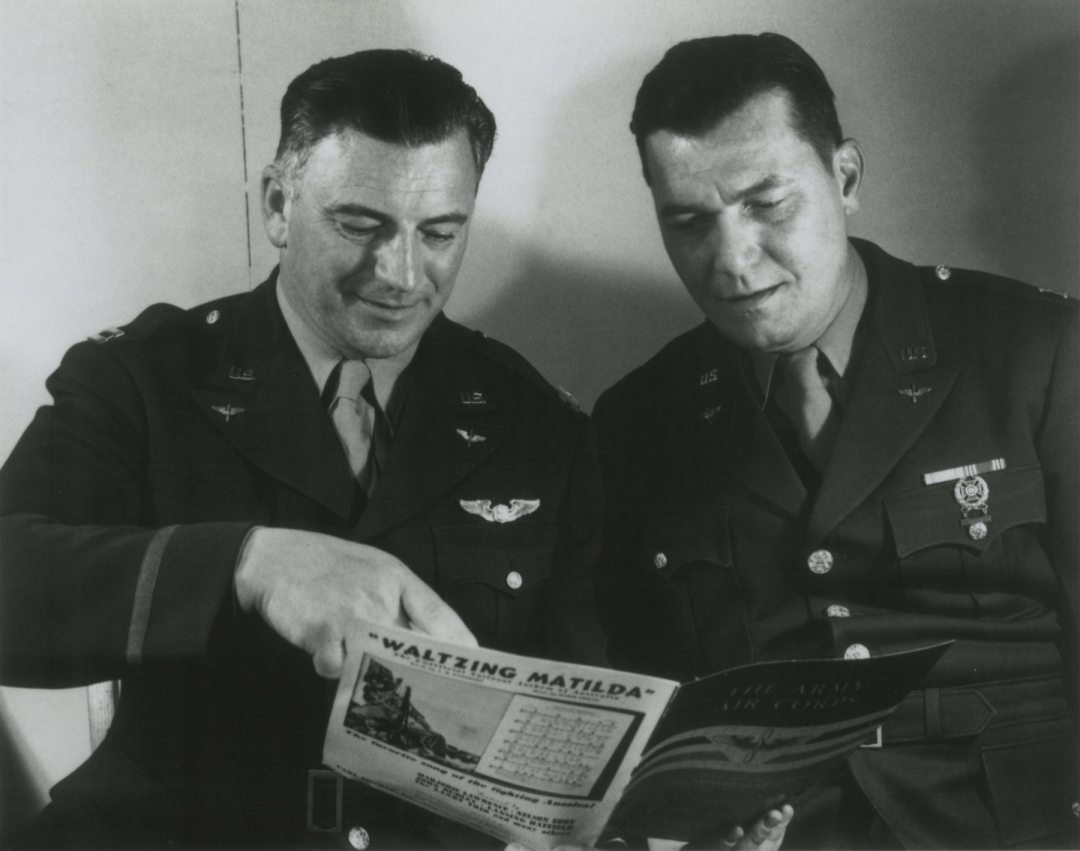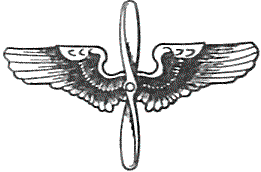The Army Air Corps (the song's original title) was a "top hit" in 1939. Fueled by the devastating attack at Pearl Harbor on Dec. 7, 1941, the song enjoyed a resurgence of popularity in 1942. With public sentiment in support of our nation at war, the fighting words of The Army Air Corps were suddenly highly appropriate and easy to remember.
The song continued to make history. The first page of the original score, penned in1939, was carried to the surface of the moon on July 30, 1971 aboard the Apollo 15 Falcon lunar module. The first and only all-Air Force crew was composed of retired Cols. David R. Scott, Alfred M. Worden and the late James B. Irwin. They arranged to take the sheet of music with them as a tribute to Crawford and the U.S. Air Force.
Today, more than a half-century later, use of The U.S. Air Force song is still protected by copyright laws. Copyrighted in 1939 as "The Army Air Corps", the National Security Act of 1947 necessitated a change in the title and lyrics. The U.S Air Force Band adjusted the wording during performances to reflect the new name. However, the published version of "The Army Air Corps" did not change to "The U.S. Air Force" until 1951. Because of the Copyright Extension Act of 1999 (which extends by 30 years the copyrights on all music published after 1923), "The U.S. Air Force" will not be in the public domain until 2044. Until then, the published sheet music must be purchased and used with the permission of the copyright holder, music-publishing company Carl Fischer, Inc. Fortunately, the U.S. Air Force has special permission to use the music "free of any royalties, license fees, or permissions for official AF use, forever."
The U.S. Air Force song continues to inspire our troops, building morale and esprit de corps. Air Force leaders recognize the importance of fighting and winning wars, and the important role music plays to influence and inspire the men and women who serve. Musicians like Robert Crawford, Glenn Miller, John Williams, Henry Mancini, Floyd Werle, Sammy Nestico, Michael Davis, Lawrence Odom, and Mike Crotty are just a few of the people who have significantly influenced the Air Force through music.
Like their historic predecessors, the music production staff of The United States Air Force Band continues that noble tradition today, creating music to entertain, inspire and recruit tomorrow's heroes.by Chief Master Sgt. Joe Tersero ---
The United States Air Force Band Chief Music Librarian
THE ARMY AIR CORPS
(Chorus)
Here's a toast to the host of those
Who love the vastness of the sky,
To a friend we send the message
Of his brother men who fly.
We drink to those who gave their all of old,
Then down we roar
to score the rainbow's pot of gold.
A toast to the host of men we boast, the Army Air Corps.
(Zoom!)
Climbing high into the sun;
Here they come zooming to meet our thunder,
At'em boys, Give 'er the gun! (Give 'er the gun now!)
Down we dive, spouting our flames from under,
Off with one hell-uv-a roar!
We live in fame or go down in flame. Hey!
Nothing'll stop the Army Air Corps!
Sent it high into the blue
Hands of men blasted the world asunder,
How they live God only knew!
Souls of men dreaming of skies to conquer
Gave us wings ever to soar,
With scouts before and bombers galore, Hey!
Nothing;ll stop the Army Air Corps!
Keep the wings level and true!
If you'd live to be a gray haired wonder,
Keep your nose out of the blue! (Out of the blue, boy!)
Flying men guarding our nation's borders,
We'll be there followed by more,
In echelon we carry on! Hey!
Nothing'll stop the Army Air Corps!
In 1938, Brig. Gen. Henry "Hap" Arnold, a true visionary, didn't feel that the Army's traditional "caisson" song was appropriate to the new role of the Army Air Corps. The lyrics, "the army goes rolling along," worked well for depicting images of tanks and armored vehicles; unfortunately, the music and the words didn't quite fit the futuristic image of our new flying service.
Maj. Gen. Oscar Westover, then chief of the Army Air Corps, was in complete agreement. Westover expressed the need for a musical composition to represent the Army Air Corps, stating, "It's a shame the Air Corps has no song of its own." Due to a lack of direct control over funding and other interservice issues, the Air Corps could not commission a composer to write a song. Determined to find a solution to this problem, Gen. Westover turned to his friend and colleague, Bernarr MacFadden.
Bernarr MacFadden, aviation enthusiast and editor of Liberty Magazine, came up with the idea to sponsor a composition contest. The winning song would be used as the official song of the Army Air Corps. The announcement, published in the Sept 10, 1938 issue, offered a cash prize of $1,000 -- a considerable sum at the time.

discusses his song with Capt. Alf Heiberg, founding conductor
of the official band of the Army Air Forces.
Next, Gen. Arnold chose a panel of Air Corps officers' wives with musical backgrounds to select the winner. Mrs. Mildred A. Yount (wife of Lt. Gen. Burton K. Yount) was selected to chair the song committee. After completing an exhausting review of nearly 800 submitted scores, the committee was ready to give up; they had not found a single suitable composition. The song had to be more than just a great song, as several of the submissions were. The music and lyrics had to be great, fit with the image of an armed service and invoke the image of flight.
Many months later, in June 1939, a man by the name of Robert M. Crawford found out about the competition. A composer and pilot himself, he certainly had the "right stuff" to write a song about the Army Air Corps.
While flying from Newark, New Jersey to Bridgeport, Conn., Crawford composed the song in his head. When he arrived home, he exclaimed to his wife, "Hessie, I've got it, that is the music! When I flew home today it just seemed to come to me... I even have a few words ... 'Off we go into the wild blue yonder'." By the next day, the song was complete.
Since the deadline for submissions was drawing near, Crawford and his wife flew to Washington, D.C., to submit the new song (not yet on paper) in person. Mrs. Yount was very impressed with Crawford's audition, due in no small part to the fact that he was an accomplished baritone vocalist. The next day Mrs. Yount's committee reviewed, approved, and submitted the song to Gen. Arnold for final approval. On Aug. 18, 1939, Arnold, in his capacity as assistant chief of the U.S. Air Corps, approved the song and thus made it official. The song was officially introduced at the Cleveland Air Races on Sept. 2, 1939.
Fittingly, Crawford sang in its first public performance. When the United States entered World War II, Crawford became a pilot in the Air Transport Command. He reverted to inactive status in 1946 and returned to music. On March 12, 1961 he passed away in New York City. He was a Lieutenant Colonel in the United States Air Force Reserve.
